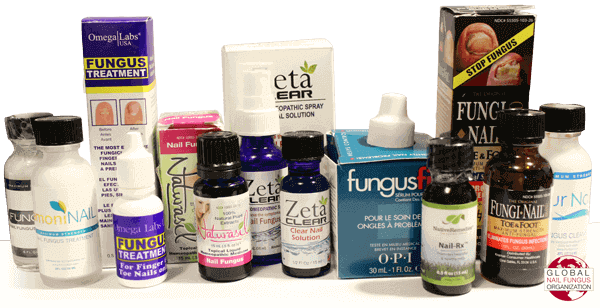Nail Fungus Symptoms
Early Symptoms of Fungal Nail Infection
Most commonly the nail becomes thickened and discolored. The nail can turn white, black, yellow or green.
- Nail Thickens
- Discolored (white, black, yellow, or green)
Moderate Symptoms
As the infection progresses there can be further symptoms, such as the nail becoming brittle, with pieces of nail breaking off or even coming away from the toe or finger completely.
- Nail Becomes Brittle and/or Crumbly
- Nail Distorts in Shape
Fully Developed Symptoms
If left untreated, the skin can sometimes become inflamed and painful underneath and around the nail (the nailbed). There may also be white or yellow patches visible on the nailbed or scaly skin next to the nail.
- Further Thickening and Darkening of Nail (Increases Difficulty for Nail Fungus Removal)
- Separation of Nail (onycholysis)
- Pain: On and Around the Nail
- Infection of Surrounding Skin
——————
Nail Fungus Risk Factors
Who is most likely to get a Fungal Infection of the Nails?
While anyone can get infected: there are certain characteristics which may make it easier for a nail fungus to develop. Aging, work, living conditions, footwear, and health issues may increase or decrease your likelihood of developing nail infections.
Nail Infections Are More common among Older Adults
As you get older, the likelihood of developing a fungal infection of your nails increases. This is due to a decrease in the circulation of your hands and feet. With less vigorous blood flow, your immune system does not detect and fight invaders, such as fungi, as well as it did when you were younger. You are also a at a higher risk of developing fungal infections as you grow older because your nails and skin have had a longer period of exposure to the infecting organisms than when you were young. According to Allison Harvey, MD FACEP, in western countries, approximately one out of ten individuals under the age of sixty contract a fungal nail infection. After the age of sixty, the rate doubles to one in five. (Harvey, 2015). A recent study, (Del Rosso, 2014) indicates that by age 70, one out of every two people are affected by a fungal nail infection.
The most common risk factor for nail fungus is Aging for the following reasons:
- Reduced blood circulation
- Increased exposure time to fungi
- Nail growth may slow with age making them more susceptible to infection and hosting of nail fungus.
Your family may Increase your odds of Contracting a Fungal Infection
If you live with someone who has a nail infection, or if you have relatives who get fungal infections, you are more at risk. Males are more likely than females to get infections of the nails. If you perspire heavily, fungi may grow faster and you may be more prone to nail infections.
Work Environments and Footwear Contribute to Nail Infections
If you are required to wear heavy footwear, such as work boots, which do not allow your feet to be properly ventilated, fungi may thrive in your shoes. Any job which entails working in hot, moist environments, especially with wet feet or hands, may lead to nail infections. Wearing socks which do not wick the moisture away from your feet will elevate the likelihood of fungi multiplying. If your hands get chaffed or are traumatized, you may get nail infections. Make sure that do not share gloves and other protective equipment with your coworkers. Wash your work clothing in hot water. Add bleach to your laundry, if possible.
Recreation and Nail Infections
Taking public showers, swimming in community pools, and soaking in public whirlpool baths exposes your body to fungi from other individuals. It is important to wear sandals or other footwear in gyms, pool areas, and community settings where fungi thrive.
Health Conditions which predispose you to the Development of Nail Infections
Certain health issues increase your chances of contracting nail infections. If you suffer from rashes, psoriasis or eczema, your skin may not be able to resist fungi and other microorganisms. Having athlete’s foot, injuries to your hands or feet, or even microscopic breaks in your skin provides fungi with entry points to invade your nails. Being diagnosed with peripheral vascular disease or diabetes puts you at risk too. If you have problems with your circulation or your immune system, it is easier for you to get fungal infections. People who have Down’s syndrome are more likely to develop nail infections. If you suffer from a chronic illness, your body may not be able to fight off infections well.
Medications and Medical Treatments Increase your Susceptibility to Fungal Infections
Any medications which impair the function of your immune system may increase your chances of developing all kinds of illnesses; including fungal infection of your nails. Steroids, and chemotherapy agents decrease your immune response. If you are taking medications which treat autoimmune disorders, such as medications for rheumatoid arthritis, your immune function may be compromised.
Radiation, surgery, and other medical therapies stress your body. While undergoing these types of treatments, you may have an elevated chance of getting infected.
Summary of risk factors for developing a nail fungus infection include:
- Use of footwear with poor ventilation. Socks which do not wick and/or absorb sweat/perspiration.
- Barefoot walking through high moisture public areas. These include public pools, public showers, and gyms.
- Exposing of damaged nails and or skin wounds.
- Skin disorders such a psoriasis adjacent to nails.
- Other fungal infections
- Issues with circulation, immune system deficiencies, and diabetes.
Preventing and Curing Fungal Infections of the Nails
Preventing Fungal Infections of Your Nails
In order to prevent fungal infections from occurring, and help them to resolve faster; you need to practice good hygiene, reduce factors which make you susceptible to infection, and be as healthy as you can be.
- Wash your hands and feet every morning and night. Be sure to dry your fingers and toes carefully.
- If you are applying topical medications to your nails, wash your hands before and after applying the medicine. Apply medication to clean nails only. Take care while applying medicine not to spread the infection to uninfected fingers and toes.
- Wear sandals, or shoes which allow your feet to receive a healthy air flow. Choose sandals which do not irritate or put pressure between your toes.
- Change your socks at least daily. Remove them promptly if they become wet or soiled. Wear socks which are designed to wick moisture from your feet.
- If your skin tends to be dry, use a moisturizer to prevent chafing and cracking of your skin.
- Wear sandals or other footwear if you are walking on public surfaces such as near pools or in gyms.
- Wash your gym shoes regularly.
- If you get professional pedicures or manicures; bring your own tools or be sure that the salon follows the correct techniques for disinfecting equipment.
- If you cut your own nails; disinfect clippers, and other tools prior to and after each use. You may soak your equipment in rubbing alcohol or another disinfecting solution. Do not share your equipment with others.
- Cut your nails straight across. Be careful not to trim them too short.
- Do not wear artificial nails or nail polish if you have an infection, or are prone to infections of your nails.
- Take measures to improve the health of your entire body. Focus on immune, circulatory, and skin health. Eat a healthy diet and get plenty of sleep.
- Quit smoking if you are a smoker, as smoking harms your immune system and your circulation.
- If you have diabetes, maintain tight blood sugar control.
- Consult with your health care provider if you have specific health issues which predispose you to nail infections.
- Inspect your nails regularly for signs of infection.
Are Fungal Infections of the Nails Curable?
It depends upon your health, what caused you to get the infection in the first place, and how serious your infection is. Rates of reinfection are high, even with the use of strong drugs. Here are some strategies which you may implement that promote healing and reduce the likelihood of reinfection.
- It is essential that you use hygienic practices which prevent the fungi from reestablishing themselves.
- Many practitioners recommend the use of topical remedies even if oral medications are prescribed. Check with your health care provider to see if he or she recommends that you use a topical remedy if you are taking a medication by mouth to treat your fungal infection.
- Be on the lookout for early signs of reinfection.
- It may be tempting to discontinue treatment if your nails begin to improve. To reduce the chance of reinfection, you must continue treatment until the nail completely grows out, as advised by your health care provider, or until you have completed the length of treatment recommended by the product manufacturer.
The keys to curing your nail fungus are patience, persistence, and a combination of treatment interventions.
Additional information on treating nail fungus with a topical solution can be found in our treatment guide:






